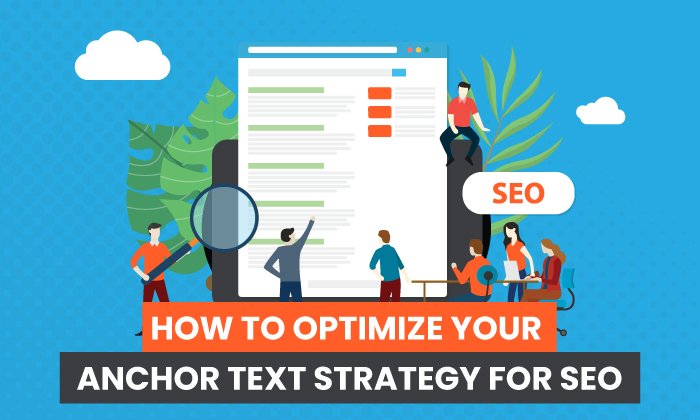
The early days of SEO were like the Wild, Wild West.
Blackhat SEO experts did everything imaginable to rank their sites on Google, including keyword stuffing and creating spammy backlinks.
It worked–for a bit.
These days, Google’s SERP Algorithm cracked down on content quality, and those older SEO hacks have long crumbled to dust. Details like anchor text matter.
Why? Because we’re working with a more intelligent, more complex algorithm. Today, there are now more than 200 Google ranking factors.
The recent Core Web Vitals update, which said websites must be fast-loading, stable, and secure, impacted more than a million websites. This means that sites must improve on-site experiences if they want to rank alongside writing and publishing your content.
Similarly, Penguin, (aka the “webspam algorithm”) has seen a few changes over the last few years. The anchor text in your backlinks and internal links is more important than ever.
Too much “noise,” and you’ll upset the algorithm. Too little, and you’ll disturb the algorithm.
It’s a delicate balance.
However, it’s worth paying attention when you consider SEO is a top priority for most marketers in 2022.
This guide will cover how to optimize your anchor texts to improve your SEO – and avoid a Google penalty that reduces your audience size considerably.
However, before we start, let’s make sure you understand what anchor text is and how it can impact SEO.
What Is Anchor Text?
There’s a good chance that you use anchor texts daily, maybe without even realizing it. Anchor text is the clickable text you see in a hyperlink.

If the internet is a highway, think of anchor texts like signs for upcoming exits.
They send signals to both your website’s users and search engines. When used correctly, they connect you to a different “lane” by allowing you to source credible information from another website.
They also play a role in helping users navigate your site and give Google’s algorithm a good idea of who your content is relevant for.
If you look at your site’s code, you will see a line that looks like this:

This is the part of your site that Google sees.
There is a section that tells your web browser and search engines which link to follow.
Here’s how that translates to what’s on your page:

When a user clicks on the link, it will take them to the indicated page.
If you’ve never dug into the details of URLs before, it’s easy to imagine that merely creating a link is where the fireworks end – but there’s a much more profound reason for brands to focus on this simple element.
Why is Anchor Text Important for SEO?
As I previously mentioned, in 2012, Google decided to rock the SEO world by releasing the Penguin algorithm. Then it was updated again recently.
Due to this change, anchor text quickly became the easiest way to determine how relevant a reliable website was.
Google also started using backlinks and its anchor texts to see if a website had been over-optimized.

Since Google penalizes over-optimization in this case, the role of the anchor text was only magnified. Since Google has updated the Penguin algorithm multiple times, it’s easy to presume we’ll see even more changes in the future.
It’s something to watch if you want to maximize ROI from your content marketing, as, sadly, when algorithms change, many brands see massive traffic dips.
Do you want that to be you?
Keep in mind, traffic dips will also mean a dip in revenue. Dip too far from too many hits, and your brand could be in trouble. That’s why finding the right balance with anchor texts is so vital to your SEO efforts.
A 2018 update hit 3.1 percent of websites that had been over-optimizing their anchor texts (and that was just from more prominent websites who reported their dip, imagine how many more suffered.)

At the very least, it’s clear that the anchor text used in backlinks is an SEO signal for the foreseeable future.
Remember: the theory behind anchor text applies to internal links as much as it applies to backlinks.
Luckily, the algorithm has wisened enough that Google will now only penalize the offending page instead of entire sites, but this could still dramatically affect your traffic and revenue in the long run.
The Different Varieties of Anchor Texts
When it comes to search engines, SEO experts like to leave no stone unturned.
In the case of anchor texts, we’ve had more than a decade to parse through all of the available information. It shouldn’t surprise you that there are many ways to create anchor texts that are both useful and useless.
1. Exact Match Anchor Text
An exact match anchor text is when you use anchor text wording as the targeted keywords for your entire page. For example, using “free SEO tool” as the anchor text to link to my SEO tool Ubersuggest.
In the early days of SEO, using exact matches several times on a single page almost guaranteed your post would do well. But, they were overused to such an extent that Google penalized overuse.
It’s still a good idea to use some exact match anchor texts. However, in general, you want to mix it up with other types of anchor texts.
2. Partial Match Anchor Text
Partial match anchor texts include your keyword along with other words. For example, using “try my SEO tool” as the anchor text for a link to Ubersuggest. As you’ll see in this article, I typically use these the most on my own site.
It’s an especially useful method for anchor text because I can still effectively include my keyword without coming across as spammy.
Google can still follow my link and have a better idea of the content on my page without suspecting me of trying to manipulate its algorithm.
Since this isn’t seen as a manipulative linking practice, it’s a highly recommended way to boost the authority of your page. But, like other strategies, you don’t want to overuse them.
I also recommend avoiding sentence-long anchor texts. These dilute any keywords you use and can confuse the user as they aren’t sure exactly what part of the sentence the link is related to.
3. Branded Anchor Text
Next, you also have branded anchor texts that rely on a brand’s name to establish authority. Here’s an example from Ahrefs:

As an outbound backlink, this is a great practice.
This is another safe and effective way to build a stronger anchor profile, as it signals to Google that you’re pointing toward other high-quality tools and services.
Of course, you also want to try to find other brands that will help you with your link-building efforts in this way as well.
Never hesitate to link to another brand, especially with a keyword attached to it. Google sees this as a healthy practice as you’re not over-linking to that brand.
4. Naked Anchor Text
This type of anchor text is easy to use–but also not the most effective. It’s commonly used for sources, such as an image or a quote. It is simply the URL pasted into a post in all its naked glory.
For example, I might say “according to www.thisisareliablesource.com, 45 percent of marketers think adding anchor text helps their website ranking.”
You can see why this isn’t a good idea.
When reading content, it’s pretty disruptive to have your attention diverted away to a reference suddenly.
It might also lead your visitor to believe you’re not as technically inclined, ultimately making them your authority.
Whenever possible, avoid this type of anchor text.
5. Generic Anchor Text
You’ve probably seen a lot of these, as they make it easier to create content that flows and even prompts a call to action.
Use this type of anchor text when you want to draw your audience’s eye to a credible source or useful tool – though not too much.
A repetitive “this page” and “read this here” link practice can get pretty boring really quickly, and it doesn’t tell Google anything about the content you’re linking to.
Instead, highlight parts of the sentence to show users what they can expect to find when they click, as I did in the first sentence of this section.
6. Latent Semantic Index Keywords (LSI)
While this next option may sound complicated, it’s really just the method that search engines use to predict what users will type into the search bar.
When I type “what is anchor” into Google, the search bar provides a series of other popular search options for me to select from.
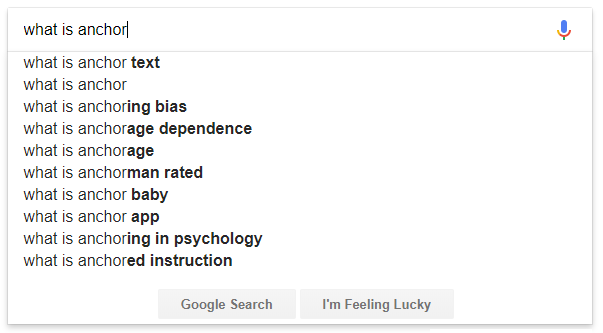
Using LSI keywords as anchor text creates search-friendly elements of your site that Google can instantly recognize as relevant to a unique search.
While there’s debate over the validity of this approach (Google’s John Muller, for example, says Google has no concept of LSI keywords.) Still, it’s not a bad idea to implement this approach to help readers understand the link context.
Of course, you want to make sure you can naturally use these keywords in your content.
“What is anchor baby” or “what is anchor app” might be difficult to use in a way that flows as a coherent thought, so be aware of that when adding these types of links.
7. Image Anchor
Image anchors make images clickable. They can help users navigate in and around your website, though be warned: they can make websites less accessible.
Links on images can move your audience to a new site when they just wanted to resize something to see it better or scroll through your post.
Most commonly, you’ll see this approach with a call to action button that is clickable, much like an ad.
In these instances, Google will read the alt tag of your image as the anchor text.
If you don’t have an alt tag optimized, Google will read it as a “NoText” anchor, which you should avoid.
This method is a great way to vary your anchor text methods and provide a more non-traditional approach.
As long as your user knows they can click on it, feel free to include one in a blog post or on your site.
Anchor Text SEO: Best Practises for Using Anchor Text in Your SEO Strategy
Now that you’ve learned more about the various types of anchor text, it’s time to dive into some best-practice SEO tips.
These will be simple, basic guides that can help you develop a more nuanced strategy with time.
Tip #1: Stay On Topic
The unfortunate truth is that there’s a lot of misconception about what good anchor text is.
However, when it comes to SEO in your linking practices, relevancy is high on the list for being ranked by Google.
They don’t want to get a bad reputation by providing users with irrelevant responses to queries.
That means your anchor text should consist of words and phrases that closely match the topic of your embedded link.
Say, for example, you run a company that offers content marketing services to small businesses.
If you want visitors to your site to navigate to a blog post you created about the importance of content, you would need to add a link.
In that link, you need to select a word or phrase as your anchor text related to your blog’s content. Otherwise, Google will see that hyperlink as manipulative and potentially penalize your site.
Here’s an example of what that could look like in your content:

I’ve used the anchor text “how to structure your URLs in the image above.”
That introduces the concept that I want my reader to understand and shows them that they should be able to find relevant information on that topic.
Here’s what you would see if you follow that link:
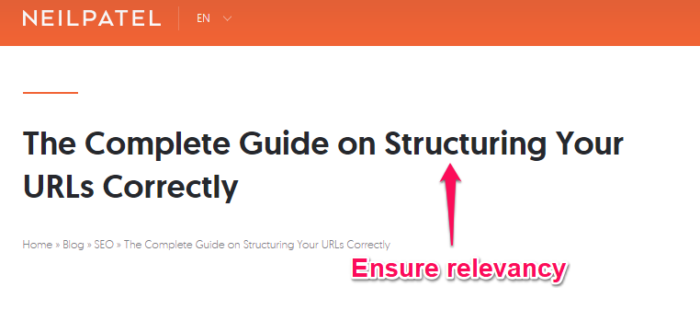
On the other side is a blog post that’s an exact match to the topic I introduced.
Imagine what would happen if instead of a helpful blog post, I linked to a page that was selling sunglasses.
You would be confused and probably wouldn’t want to follow another link on my blog. You probably wouldn’t come back and read my content because it is seen as manipulative.
So Google isn’t the only one looking for relevance here–the reader is, too.
If you want to establish trust with your website’s visitors, they need to know that you’re using sources and linking practices in their interest.
Additionally, research shows having at least one keyword anchor that signals relevancy creates a greater chance of your content ranking higher.

That means Google still values a keyword-relevant anchor text that provides a good idea about the topic of your content.
As long as you try to keep at least some of your anchor texts relevant, Google will have an easier time categorizing your content and ranking you accordingly.
Tip #2: Always Incorporate Variation
If you always want an exact match, Google’s spam filter will go off, and you’ll take a hit.
You’ll probably have a similar effect if you always only link to brand names.
When it comes to creating a strategy for anchor texts that helps SEO, it is best to use your own unique and varied approach.
That flies in the face of the typical advice you see that focuses on which anchor texts you should use based on specific ratios.
For a home page, you’d be inclined to use 5 percent exact match, 20 percent phrase match, and 10 percent key phrases.
However, recommendations vary widely based on who provides the advice and even what industry you are in.
In most cases, you can follow the prescribed advice and attempt to establish a baseline strategy for your anchor text practices. Once you get that baseline, do what works best to boost your SEO and organic rankings–and that requires a more in-depth evaluation.
You can always check out what your competition is doing if you are struggling!
I make this recommendation based on a study that displayed the after-effects of Penguin 4.0 on a variety of different brands across different niches.
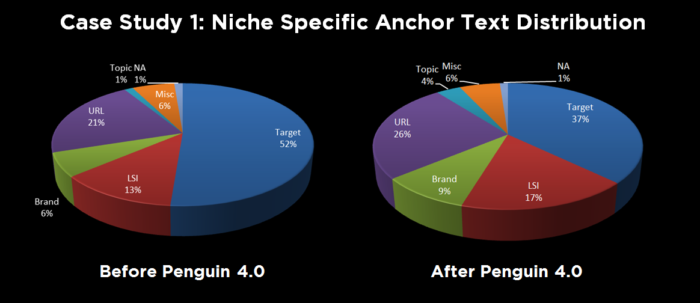
After the update, the first brand decreased its “target” or exact match keywords and redistributed its anchor text strategy more widely.
Once the changes were implemented, it fought its way back to its pre-Penguin 4.0 standing on Google.
Just compare the graph above to this one:

The most notable difference is that they are different, but, in each case, both are ranking well. So what does that mean for ration prescriptions and other similar anchor text optimization schemes?
You should take them with a grain of salt.
While it might work for one brand, there’s no guarantee it will work for you. Plus, it’s incredibly tedious to try and exactly match another brand’s strategy to the letter.
Instead, you should focus on creating a more natural distribution for your anchor text scheme.

All of these variations rely on very natural language and display a clear intent to both search engines and your user.
By focusing on experimentation and natural language in your anchor texts, you’re more likely to see better results in the long run.
Tip #3: Test and Track Your Anchor Texts
Tracking how you use anchor texts on your site will take a bit of effort, but it’s the only way to test how they affect your SEO over time.
To start tracking the variety of anchor texts you use, I recommend using the Anchor Text Categorizer Tool by Linkio.
This tool asks you to fill in various details about your content, including the URL, page title, brand name, and keywords.
You should also fill in the exact anchor texts you use in the content, as you can see below.

In this case, I’ve filled in a few from an actual blog post on my site.

There’s also a helpful percentage calculator just to the side of your screen.
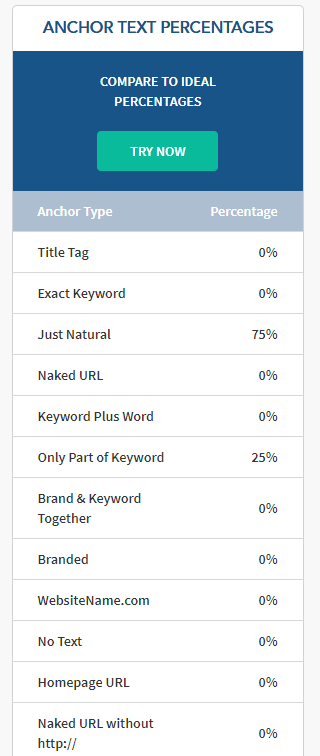
This is where you can start creating a baseline for your anchor text procedure.
As I mentioned in the previous point, you can attempt to implement another brand’s scheme or develop your own. As long as you see a wide variety of anchor texts that help your SEO, then you’re taking the right approach.
Another good idea is to start using Semrush to keep tabs on what types of anchor texts link to your site. To find this info, you’ll need to navigate to the Backlinks tab of the Semrush dashboard.
From there, you’ll click on the option that says “Anchors”.

Now you can see which terms are being used by other brands when they link to your site.
Remember that anchor texts are largely used by Google as a signal of content relevancy and domain authority, so these anchor texts are vital to your SEO.
In my case, most anchors to my site are either my name or something marketing-related.

That’s good because my name is my brand, and I help businesses grow through digital marketing.
These anchor texts took years to build, but because of the content I produce and the relationships I’ve built, they help my SEO, and in many cases, help my articles rank on the first page of Google.
With enough time and the right approach to your own backlinking, you can build this type of backlink anchor base for your own brand and see excellent results.
Anchor Text Strategy for SEO Frequently Asked Questions
What is anchor text?
Anchor text is the clickable text that you see in online content that takes you to a new page. It is often underlined or colored blue. Like this.
Why does anchor text matter?
Google uses anchor text to determine if a link is relevant and valuable. It’s not the most crucial ranking factor, but it does impact SEO. Additionally, readers use anchor text to determine if they will click a link.
What are the different types of anchor text?
The types of anchor text are:
- Exact match: Use the same keywords as the targeted keywords for your page.
- Partial Match: Include the keyword along with other keywords.
- Branded Anchor Text: Add a link to the name of the brand.
- Naked Anchor Text: Uses the entire URL as the link.
- Generic Anchor Text: Phrases like “click here” or “this page.”
- Latent Semantic Index: Also known as LSI, these are keywords that search engines predict users will search for when they are searching for a particular word or phrase.
What are some tips for optimizing anchor text?
Some best practices for anchor text SEO are: stay on topic, keep a consistent structure, incorporate variation, and test and track your anchor text. When possible, use keywords–but don’t overdo it.
Google uses anchor text to determine if a link is relevant and valuable. It’s not the most crucial ranking factor, but it does impact SEO. Additionally, readers use anchor text to determine if they will click a link.
The types of anchor text are:
- Exact match: Use the same keywords as the targeted keywords for your page.
- Partial Match: Include the keyword along with other keywords.
- Branded Anchor Text: Add a link to the name of the brand.
- Naked Anchor Text: Uses the entire URL as the link.
- Generic Anchor Text: Phrases like “click here” or “this page.”
- Latent Semantic Index: Also known as LSI, these are keywords that search engines predict users will search for when they are searching for a particular word or phrase.
Some best practices for anchor text SEO are: stay on topic, keep a consistent structure, incorporate variation, and test and track your anchor text. When possible, use keywords–but don’t overdo it.
Anchor Text SEO Conclusion
Anchor texts are important. While they won’t tank your SEO on their own, they are a ranking factor for SEO. Additionally, they can impact reader trust.
Google has had anchor texts and backlinks on an ever-tightening leash, so it’s a good idea to ensure you use the best approach for your SEO.
It’s also a good idea to implement a unique backlink variation strategy based on your research results.
Using tools like Anchor Text Categorizer and Semrush will ensure that you don’t miss any important changes to your anchor text SEO efforts.
These tips will create an anchor text strategy strong enough to boost your SEO and weather any future changes.
What strategies have you used to improve your anchor texts?
